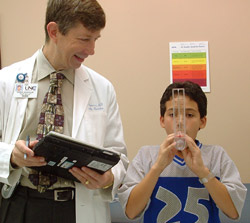Ozone and Your Patients' Health
About this Course
 |
Clinical ScenariosThe Clinical Scenarios section of this course discusses the following scenario and others in detail. A 12-year-old girl and her mother arrive at your office for an evaluation of the child's asthma. At soccer practice the girl experienced chest tightness and shortness of breath, and she woke up during the night wheezing. Yesterday was a Code Red air quality day for ozone. The mother asks, "Do you think ozone caused her wheezing? Should I make her skip practice on Code Red ozone days?" |
During the summer months, millions of people in the United States are exposed to the ambient air pollutant ozone at levels that can cause uncomfortable but reversible respiratory symptoms as well as a number of more serious health effects. Ozone and Your Patients' Health is a short, evidence-based training course that:
- Describes the physiological mechanisms responsible for the lung function changes and symptoms caused by exposure to ground-level ozone
- Describes the relationships observed between ground-level ozone and other adverse health effects
- Discusses in detail the effects of ozone exposure on patients with asthma
- Helps health care providers advise their patients about exposure to ozone
- Provides practical Patient Education Tools to help patients understand what triggers their symptoms and how to alleviate them
Ozone and Your Patients' Health is designed for family practice doctors, pediatricians, nurse practitioners, asthma educators, and other medical professionals who counsel patients about asthma, air pollution, or exercise. Patients and their families may also use this material to learn the science behind ozone’s effect on respiration and how to manage their respiratory health using the Air Quality Index.
Course Objectives
Upon completion of this course, you will be able to:
- Describe how ozone is formed and where it is found
- Identify the effects that exposure to ozone has on the general population
- List the different effects of ozone at varying exposure concentrations and durations
- Identify the effects that ozone has on asthma patients
- Explain the purpose and use of the Air Quality Index
- Identify common sources of information about the Air Quality Index
- Address typical patient questions and clinical scenarios relating to ozone exposure
How to Use This Training
You can complete this course in order by using the  and
and  links at the bottom of each page or you can use the navigation links in the sidebar at the left to take the training in whatever order you choose. Total time to complete the course is approximately 1.5 hours.
links at the bottom of each page or you can use the navigation links in the sidebar at the left to take the training in whatever order you choose. Total time to complete the course is approximately 1.5 hours.
What is Ozone? - How ozone is formed and where it is found.
Health Effects in the General Population - Health effects that are observed in broad segments of the population, including respiratory symptoms, reduced lung function, and airway inflammation.
Health Effects in Patients with Asthma and Other Chronic Respiratory Disease - Focuses on the population that has been identified to be the most acutely responsive to ozone exposure.
Patient Exposure and the Air Quality Index - Explains the purpose and use of the Air Quality Index.
Clinical Scenarios - 4 clinical scenarios to test your knowledge.
Frequent Questions - Information for counseling patients about ozone, asthma, and respiratory symptoms.
Course Outline/Key Points - Outline of the course and key points in each section.
Review Questions - Test your knowledge.
Patient Education Tools - Includes downloadable publications (with a link to Spanish publications) and links to related EPA Web pages.
Course Evaluation - Provide feedback for the course.
References & Figures - References for the course development and a compilation of the Figures within the course.
Glossary - Key terms and acronyms.
Course Evaluation
Please provide feedback for this course through the Course Evaluation page.
